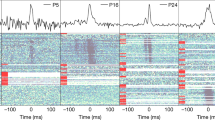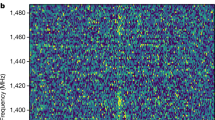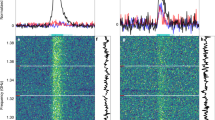Abstract
In recent years, millisecond-duration radio signals originating in distant galaxies appear to have been discovered in the so-called fast radio bursts1,2,3,4,5,6,7,8,9. These signals are dispersed according to a precise physical law and this dispersion is a key observable quantity, which, in tandem with a redshift measurement, can be used for fundamental physical investigations10,11. Every fast radio burst has a dispersion measurement, but none before now have had a redshift measurement, because of the difficulty in pinpointing their celestial coordinates. Here we report the discovery of a fast radio burst and the identification of a fading radio transient lasting ~6 days after the event, which we use to identify the host galaxy; we measure the galaxy’s redshift to be z = 0.492 ± 0.008. The dispersion measure and redshift, in combination, provide a direct measurement of the cosmic density of ionized baryons in the intergalactic medium of ΩIGM = 4.9 ± 1.3 per cent, in agreement with the expectation from the Wilkinson Microwave Anisotropy Probe12, and including all of the so-called ‘missing baryons’. The ~6-day radio transient is largely consistent with the radio afterglow of a short γ-ray burst13, and its existence and timescale do not support progenitor models such as giant pulses from pulsars, and supernovae. This contrasts with the interpretation8 of another recently discovered fast radio burst, suggesting that there are at least two classes of bursts.
This is a preview of subscription content, access via your institution
Access options
Subscribe to this journal
Receive 51 print issues and online access
$199.00 per year
only $3.90 per issue
Buy this article
- Purchase on Springer Link
- Instant access to full article PDF
Prices may be subject to local taxes which are calculated during checkout



Similar content being viewed by others
References
Lorimer, D. R., Bailes, M., McLaughlin, M. A., Narkevic, D. J. & Crawford, F. A bright millisecond radio burst of extragalactic origin. Science 318, 777–780 (2007)
Keane, E. F., Stappers, B. W., Kramer, M. & Lyne, A. G. On the origin of a highly dispersed coherent radio burst. Mon. Not. R. Astron. Soc. 425, L71–L75 (2012)
Thornton, D. et al. A population of fast radio bursts at cosmological distances. Science 341, 53–56 (2013)
Spitler, L. G. et al. Fast radio burst discovered in the Arecibo pulsar ALFA survey. Astrophys. J. 790, 101–110 (2014)
Burke-Spolaor, S. & Bannister, K. W. The galactic position dependence of fast radio bursts and the discovery of FRB 011025. Astrophys. J. 792, 19–26 (2014)
Ravi, V., Shannon, R. M. & Jameson, A. A fast radio burst in the direction of the Carina dwarf spheroidal galaxy. Astrophys. J. 799, L5–L10 (2015)
Petroff, E. et al. A real-time fast radio burst: polarization detection and multiwavelength follow-up. Mon. Not. R. Astron. Soc. 447, 246–255 (2015)
Masui, K. et al. Dense magnetized plasma associated with a fast radio burst. Nature 528, 523–525 (2015)
Champion, D. et al. Five new fast radio bursts from the HTRU high latitude survey: RST evidence for two-component bursts. Mon. Not. R. Astron. Soc . (submitted); preprint at http://arxiv.org/abs/1511.07746 (2015)
McQuinn, M. Locating the “missing” baryons with extragalactic dispersion measure estimates. Astrophys. J. 780, L33 (2014)
Zhou, B., Li, X., Wang, T., Fan, Y.-Z. & Wei, D.-M. Fast radio bursts as a cosmic probe? Phys. Rev. D 89, 107303 (2014)
Hinshaw, G. et al. Nine-year Wilkinson Microwave Anisotropy Probe (WMAP) observations: cosmological parameter results. Astrophys. J . 208 (Suppl.), 19 (2013)
Chandra, P. & Frail, D. A. A. Radio-selected sample of gamma-ray burst afterglows. Astrophys. J. 746, 156 (2012)
Cordes, J. M. & Lazio, T. J. W. NE2001.I. A new model for the Galactic distribution of free electrons and its fluctuations. Preprint at http://arxiv.org/abs/astro-ph/0207156 (2002)
Bhat, N. D. R., Cordes, J. M., Camilo, F., Nice, D. J. & Lorimer, D. R. Multifrequency observations of radio pulse broadening and constraints on interstellar electron density microstructure. Astrophys. J. 605, 759–783 (2004)
Bell, M. E. et al. A search for variable and transient radio sources in the extended Chandra Deep Field South at 5.5 GHz. Mon. Not. R. Astron. Soc. 450, 4221–4232 (2015)
Brown, M. J. I., Jannuzi, B. T., Floyd, D. J. E. & Mould, J. R. The ubiquitous radio continuum emission from the most massive early-type galaxies. Astrophys. J. 731, L41 (2011)
Mooley, K. P. et al. The Caltech-NRAO Stripe 82 Survey (CNSS) paper I: the pilot radio transient survey in 50 deg2. Astrophys. J. (in the press); http://arxiv.org/abs/1601.01693 (2016)
Ioka, K. The cosmic dispersion measure from gamma-ray burst afterglows: probing the reionization history and the burst environment. Astrophys. J. 598, L79–L82 (2003)
Inoue, S. Probing the cosmic reionization history and local environment of gamma-ray bursts through radio dispersion. Mon. Not. R. Astron. Soc. 348, 999–1008 (2004)
Dolag, K., Gaensler, B. M., Beck, A. M. & Beck, M. C. Constraints on the distribution and energetics of fast radio bursts using cosmological hydrodynamic simulations. Mon. Not. R. Astron. Soc. 451, 4277–4289 (2015)
Xu, J. & Han, J. L. Extragalactic dispersion measures of fast radio bursts. Res. Astron. Astrophys. 15, 1629 (2015)
Fukugita, M. & Peebles, P. J. E. The cosmic energy inventory. Astrophys. J. 616, 643–668 (2004)
Bregman, J. N. The search for the missing baryons at low redshift. Annu. Rev. Astron. Astrophys. 45, 221–259 (2007)
Staveley-Smith, L. et al. The Parkes 21 cm multibeam receiver. Publ. Astron. Soc. Aust . 13, 243–248 (1996)
Pietka, M., Fender, R. P. & Keane, E. F. The variability time-scales and brightness temperatures of radio flares from stars to supermassive black holes. Mon. Not. R. Astron. Soc. 446, 3687–3696 (2015)
Fong, W., Berger, E., Margutti, R. & Ashley, B. A. A decade of short-duration gamma-ray burst broad-band afterglows: energetics, circumburst densities, and jet opening angles. Astrophys. J. 815, 102 (2015)
Berger, E. Short-duration gamma-ray bursts. Annu. Rev. Astron. Astrophys. 52, 43–105 (2014)
Frail, D. A., Kulkarni, S. R., Nicastro, L., Feroci, M. & Taylor, G. B. The radio afterglow from the γ-ray burst of 8 May 1997. Nature 389, 261–263 (1997)
Kulkarni, S. R., Ofek, E. O. & Neill, J. D. The Arecibo fast radio burst: dense circum-burst medium. Preprint at http://arxiv.org/abs/1511.09137 (2015)
Zheng, Z., Ofek, E. O., Kulkarni, S. R., Neill, J. D. & Juric, M. Probing the intergalactic medium with fast radio bursts. Astrophys. J. 797, 71 (2014)
Dennison, B. Fast radio bursts: constraints on the dispersing medium. Mon. Not. R. Astron. Soc. 443, L11–L14 (2014)
Hotan, A. W., van Straten, W. & Manchester, R. N. PSRCHIVE and PSRFITS: an open approach to radio pulsar data storage and analysis. Publ. Astron. Soc. Aust . 21, 302–309 (2004)
Tingay, S. J. et al. The Murchison Widefield Array: The Square Kilometre Array precursor at low radio frequencies. Publ. Astron. Soc. Aust . 30, e007 (2013)
Abbott, B. P. et al. LIGO: the Laser Interferometer Gravitational-Wave Observatory. Rep. Prog. Phys. 72, 076901 (2009)
Becker, R. H., Helfand, D. J., White, R. L. & Proctor, D. D. Variable radio sources in the Galactic Plane. Astron. J. 140, 157–166 (2010)
Ofek, E. O. et al. A very large array search for 5 GHz radio transients and variables at low galactic latitudes. Astrophys. J. 740, 65 (2011)
Frail, D. A., Kulkarni, S. R., Ofek, E. O., Bower, G. C. & Nakar, E. A revised view of the transient radio sky. Astrophys. J. 747, 70 (2012)
Croft, S., Bower, G. C. & Whysong, D. The Allen Telescope Array Pi GHz Sky Survey. III. The ELAIS-N1, Coma, and Lockman hole fields. Astrophys. J. 762, 93 (2013)
Gal-Yam, A. et al. Radio and optical follow-up observations of a uniform radio transient search: implications for gamma-ray bursts and supernovae. Astrophys. J. 639, 331–339 (2006)
Miyazaki, S. et al. Subaru Prime Focus Camera—Suprime-Cam. Publ. Astron. Soc. Jpn 54, 833–853 (2002)
Davenport, J. R. A. et al. The SDSS-2MASS-WISE 10-dimensional stellar colour locus. Mon. Not. R. Astron. Soc. 440, 3430–3438 (2014)
Cohen, M., Wheaton, W. A. & Megeath, S. T. Spectral irradiance calibration in the infrared. XIV. The absolute calibration of 2MASS. Astron. J. 126, 1090–1096 (2003)
Jarrett, T. H. et al. The Spitzer-WISE survey of the ecliptic poles. Astrophys. J. 735, 112 (2011)
Brammer, G. B., van Dokkum, P. G. & Coppi, P. EAZY: a fast, public photometric redshift code. Astrophys. J. 686, 1503–1513 (2008)
da Cunha, E., Charlot, S. & Elbaz, D. A simple model to interpret the ultraviolet, optical and infrared emission from galaxies. Mon. Not. R. Astron. Soc. 388, 1595–1617 (2008)
Faber, S. M. & Jackson, R. E. Velocity dispersions and mass-to-light ratios for elliptical galaxies. Astrophys. J. 204, 668–683 (1976)
Bullock, J. S. et al. Profiles of dark haloes: evolution, scatter and environment. Mon. Not. R. Astron. Soc. 321, 559–575 (2001)
Kennicutt, R. C. Jr. The global Schmidt law in star-forming galaxies. Astrophys. J. 498, 541–552 (1998)
Acknowledgements
The Parkes radio telescope and the Australia Telescope Compact Array are part of the Australia Telescope National Facility, which is funded by the Commonwealth of Australia for operation as a National Facility managed by CSIRO. Parts of this research were conducted by the Australian Research Council Centre of Excellence for All-sky Astrophysics (CAASTRO) and used the gSTAR national facility at Swinburne University of Technology. Parts of this work are based on data collected at the Subaru Telescope, which is operated by the National Astronomical Observatory of Japan, the Murchison Radio-astronomy Observatory operated by CSIRO, the Giant Metrewave Radio Telescope (GMRT), which is run by the National Centre for Radio Astrophysics of the Tata Institute of Fundamental Research, the Sardinia Radio Telescope as part of scientific commissioning of the telescope, and the 100-m telescope of the MPIfR at Effelsberg. We acknowledge the Wajarri Yamatji people as the traditional owners of the MWA Observatory site.
Author information
Authors and Affiliations
Contributions
E.F.K. is the principal investigator of the SUPERB project, created SUPERB survey infrastructure at Parkes and Swinburne, led survey planning, formulated and wrote (with input from co-authors) the contents of this manuscript, performed the ΩIGM calculation, calculated the FRB spectral index, produced the FRB waterfall plot and the light curve plot. S.J. and S.B. performed ATCA observations and data analysis. S.J. and B.W.S. worked on radio light curve interpretation. S.B., N.D.R.B. and P.C. performed GMRT observations and data analysis. E.B. created survey infrastructure at Parkes and Swinburne and created the MWA shadowing infrastructure. Additionally, E.F.K., S.J., S.B., E.B., N.D.R.B., M. Burgay, M.C., C.F., M.K., E.P., A.P., W.v.S., M. Bailes., S.B.-S. and R.P.E. all performed observations for the SUPERB survey at Parkes. A.J. created and maintained the Parkes and Swinburne hardware and software infrastructure and performed data management for the SUPERB project. M. Bailes additionally provided Parkes and Swinburne hardware. C.F. and M.K. also worked on the calculation of the cosmic density of ionized baryons in the intergalactic medium. M.K. additionally performed FRB radio profile fitting. Polarization analysis of the FRB signal was performed by M.C., E.P. and W.v.S. W.v.S. also produced the polarization profile plot. E.P. additionally performed the Swift analysis. Non-imaging radio follow-up was performed by M. Burgay, A.P. and D.P. with the Sardinia Radio Telescope, by R.P.E. and M. Berezina with the Effelsberg Radio Telescope, and by B.W.S., M.M. and C.B. at the Lovell Telescope at Jodrell Bank. T. Totani, M.H., H.F., T.H., T.M., Y.N., H.S., T. Terai, N.T, S.Y. and N.Y. performed the Subaru observations. T. Totani, T.H., N.T. and S.Y. additionally performed Subaru data analysis, determined the spectral redshift and created the optical profile plot. C.F., T. Totani, S.Y. and R.A. performed the optical profile fitting. J.C. performed data analysis on the Keck and Subaru data, also obtained the spectral redshift and produced the optical spectrum plot. J.J. performed the Palomar observations. M.M.K. performed the Keck observation. MWA observations were performed by N.D.R.B., D.L.K., S.J.T., A.W. and R.W. with data analysis by D.L.K. and S.J.T. D.L.K. additionally measured the photometric redshift and produced the RGB (red–green–blue) image and photo-z plots (Extended Data Fig. 1).
Corresponding author
Ethics declarations
Competing interests
The authors declare no competing financial interests.
Extended data figures and tables
Extended Data Figure 1 The photometric redshift of the FRB host galaxy.
A χ2 fit of the redshift of the galaxy based on the spectral energy (Lv) distribution is shown. The photometric redshift determined from this is 0.48 < z < 0.56 (68% confidence, denoted by the shaded regions). Two spectral fits are shown, and these are denoted by the red and blue shading respectively. The spectral redshift is denoted by the dashed vertical line. The inset shows the spectral energy distribution fit, with the seven photometric estimates overplotted with 1σ error bars.
Extended Data Figure 2 The optical surface brightness profile of the FRB host galaxy.
The surface brightness profile of the galaxy in the Subaru i′ band image was fitted to an ellipsoidal Sersic function. Best-fit values for the half-light radius (Re), Sersic index (n), axis ratio (b/a) and position angle (PA) are given in the inset. The model profiles and data are shown as the flux along an ellipse as a function of semi-major axis. The image point spread function (PSF) profile is also shown as a function of radius. Error bars give the root-mean-square scatter of the pixel counts along the axis.
Rights and permissions
About this article
Cite this article
Keane, E., Johnston, S., Bhandari, S. et al. The host galaxy of a fast radio burst. Nature 530, 453–456 (2016). https://doi.org/10.1038/nature17140
Received:
Accepted:
Published:
Issue Date:
DOI: https://doi.org/10.1038/nature17140
This article is cited by
-
Fast radio bursts at the dawn of the 2020s
The Astronomy and Astrophysics Review (2022)
-
TAROT Reunion a telescope based on the Rapido design for reliable optical observations of fast transients
Experimental Astronomy (2019)
-
The future of fast radio burst science
Nature Astronomy (2018)
-
Black Hole Information Problem and Wave Bursts
International Journal of Theoretical Physics (2018)
-
A model of neutron-star–white-dwarf collision for fast radio bursts
Astrophysics and Space Science (2018)
Comments
By submitting a comment you agree to abide by our Terms and Community Guidelines. If you find something abusive or that does not comply with our terms or guidelines please flag it as inappropriate.



